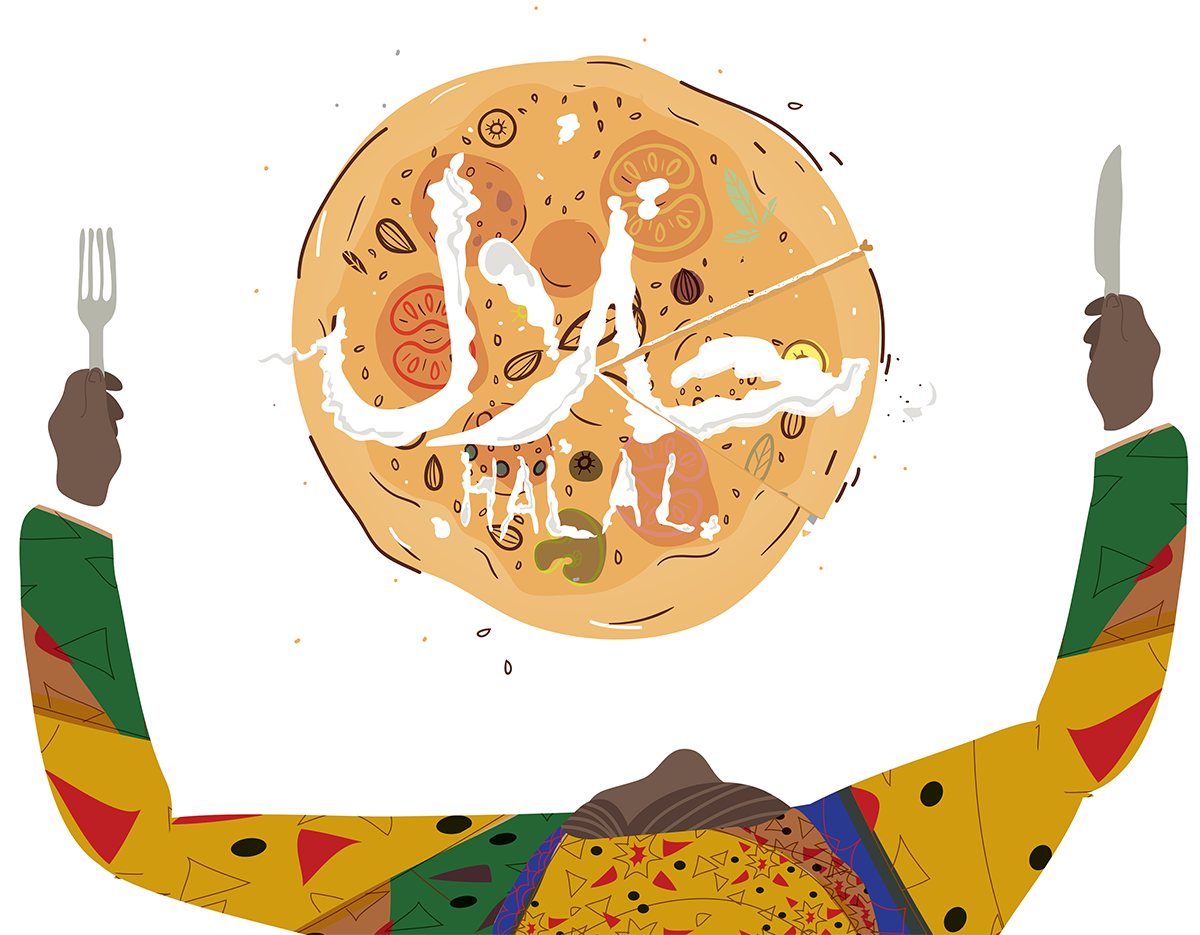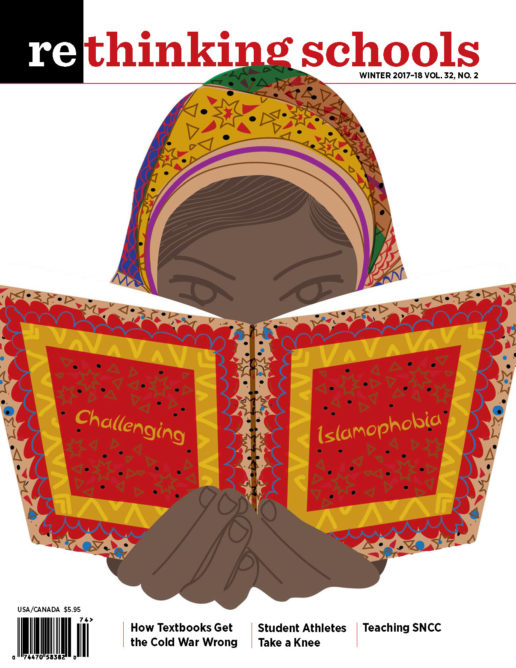Inclusivity is Not a Guessing Game
Illustrator: Khalid Albaih (@khalidalbaih and www.facebook.com/KhalidAlbaih)

“Miss, I can’t eat this. It’s not halal.”
Noor’s shoulders slumped, clearly disappointed, as she looked down into her treat bag from Ben’s 6th birthday party. She walked over, frowning, holding it open to show me the contents. The bag was filled with gummy candy made from gelatin, which is animal-based and generally sourced from pig connective tissue, bone, and/or skin. It was not labeled as halal, which means permissible, and is a way of certifying certain food as being in compliance with Islamic law. Halal gelatin is often either from halal-certified beef or poultry or made from fish or vegetable-based sources.
This wasn’t the first time Noor had come to me frustrated with birthday sweets she couldn’t eat. Before, the best I could do was tell her I was sorry and make sure she knew I understood her disappointment, but anyone who’s ever met a 5-year-old can tell you how poor of a consolation prize that is. This time I was prepared. I’d been saving chocolates and other animal product-free candies from other kids’ birthdays to make sure all of my students could fully be part of our class celebrations. Noor was thrilled to be able to exchange her non-halal candy for something she could actually eat. She called her classmates Zeeshan and Amira over, and I traded gummies for chocolates for all three.
After graduating college in the United States, I was hired by a U.K.-based teaching agency to work in a suburb east of London that had a severe teacher shortage. My first placement was as a long-term substitute in the kindergarten classroom where I taught Noor, Zeeshan, Amira, and 25 other 5-year-olds. My school reflected the area’s changing demographics: The formerly majority white British suburb was growing, and many of my kids were Muslim and whose families were from Commonwealth countries like India, Pakistan, and Nigeria. I was more aware of their experiences than I previously had been because my boyfriend at the time, who grew up in a British-Pakistani family in the next suburb over, would often talk about his own experiences as a Muslim student in the U.K. He had painful memories of being one of only a few Muslim kids in school, often feeling unintentionally left out or deliberately ostracized. He was never made to feel comfortable embracing his whole identity as a British Muslim. He’d hoped school environments had changed for the better and I wanted to do as much as I could, even if I was playing only a small role, to try to make sure they had. This is part of the reason why I already had an understanding of what the word halal meant and how I could provide an alternative for Noor and others.
Just as providing halal alternatives for students can create a more inclusive environment, so does understanding and making space for Islamic and other religious holidays in school culture and calendars. Being intentional matters. Holidays can be a major part of our students’ lives and often exist at the intersection of culture, religion, community, and home. They can help make sure students feel welcome, recognized, and safe inside the school building. Ramadan, the holy month in Islam during which many Muslims fast from sunrise to sunset, might sound overwhelming to unfamiliar teachers and schools acutely aware of the disruption caused by holidays already built into the school calendar. But the month of fasting is not disruptive — like all holidays it can be a great opportunity for learning, celebration of identity, and sharing — and schools can do simple things to be welcoming and accommodating for students who are fasting. When I started teaching in Seattle, I borrowed an idea from another school where I’d taught in London and offered the art room as an alternative to the cafeteria for Muslim students who chose to fast during Ramadan, hosting a coloring and reading club there during lunchtime.
One year, every lunch during Ramadan, 2nd-grader Safa came to my classroom, ready to choose a new how-to-draw video from a favorite YouTube channel or to draw from her imagination. Occasionally she brought her friend Wardah. Fasting is not required in most traditions for most elementary-aged kids, but Safa liked being part of something her parents and older siblings were also doing. I cherished the opportunity to learn more about my student’s life, hearing how her family was planning to celebrate Eid al-Fitr (the celebration to mark the end of Ramadan) and her plans to visit extended family halfway around the world later that summer. Safa liked feeling supported at school in her faith, and I knew from her mom’s emails that the support was appreciated by her family as well.
Through all lessons and subjects, our students’ lives and the politics surrounding their identities are always present. As essential as it is to create inclusive spaces for students to simply be, we should also aim to create opportunities to incorporate their culture and religion into projects and lessons. This doesn’t mean that we should make assumptions about how students will choose to identify, but rather that we should be deliberate and direct in letting students know they are safe to include whatever aspects of their identity they choose into their projects.
Last year, I had to confront whether I was doing enough to create an inclusive environment in my art room as the 3rd graders began a printmaking project based on their cultural identities and heritage. Students were asked to design two motifs that represented their culture. I chose images of the Midwest and Indiana for my examples, and our whole-class discussion produced ideas related to food, clothing, and flags. Culture is a complicated subject, and open-ended and autobiographical projects typically need a little extra scaffolding, so I wasn’t alarmed when most of the class hesitated after the demonstration and discussion. I expected it to be a challenging but rewarding project. I met one-on-one with kids and discussed their ideas in small groups, and eventually most picked up pencils and began sketching. Then I noticed Ibrahim quietly staring down at his sheet, his eyebrows looking unmistakably frustrated.
Our students are of course not immune to the Islamophobia, xenophobia, and racism we hear every day in media, in our communities, and from the current administration and those supportive of its views. Ibrahim’s ideas for his motifs seemed to bump up against this. He wanted to explore his identity as a Somali-American Muslim, but was hesitant to begin his sketch.
Not all of my students felt this hesitation (for example, one of Ibrahim’s classmates raced to include Pakistan’s flag as one of his motifs — the other being a not quite explained dinosaur) but Ibrahim felt differently. He was unsure if he could include the stylized Arabic script for Allah as part of his project and asked me for permission. “I can do that?” he said, seemingly surprised that I said he could. I don’t think he said more than “Well, you know” when I asked why not, but I wanted to reassure him he could use it if he wanted to. Without being certain of the source of his hesitation it’s easy to assign my own biases and political anxieties, but I wanted him to know his self-expression was always safe in my room.
Ibrahim chose a Somali flag as his other motif. He took his time on his planning and on the final print, meticulously coloring in the Styrofoam printing plate and carefully printing a repeating pattern of his two motifs on a long strip of paper. He was proud of his final project and his classmates enjoyed learning about these two important parts of his identity from him when they talked about their projects as part of small group “verbal exit tickets.”
Making classrooms and schools safe for all students is an exercise in lifelong learning and listening. I have often relied on the help and advice of Muslim friends and now my husband (who grew up in a Muslim family and country), as well as online research. It’s a privilege to have these close resources, but any teacher with Muslim students can start by creating opportunities to listen to students, parents, and families as they speak and share their needs. We can use or create curriculum and projects that allow students to learn about and incorporate their culture and religious practices if they want to. We can be deliberate in including, making space for, and recognizing our students in all aspects of their identities. Making schools inclusive doesn’t have to be a guessing game.
Chelsea Vaught is an artist, writer, and art educator currently living in Seattle. Originally from the Chicago area, she has taught general education and visual art with an emphasis on student-directed work in elementary classrooms in both the United States and United Kingdom.

